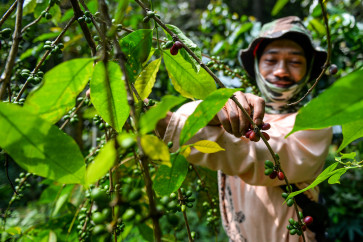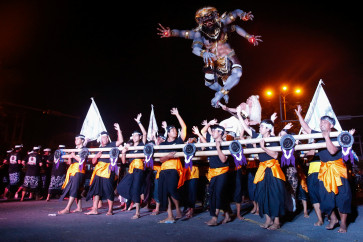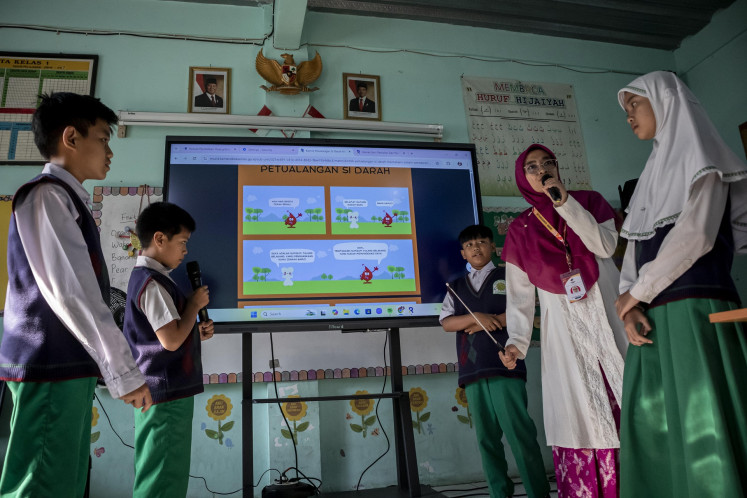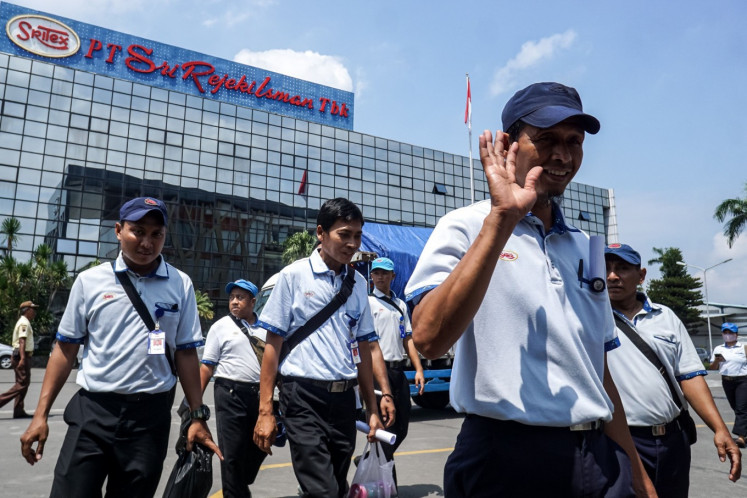A brief spot of joy amid the mud
It is nearly 9 a
Change text size
Gift Premium Articles
to Anyone

I
t is nearly 9 a.m., and as the excited voices of children grow louder, women hunt for their costumes and giant puppets lie on the ground, waiting to be brought to life over the next few hours.
Who is responsible? Members of Iafadl, an NGO from Yogyakarta, and Taring Padi, an artist community, carry a giant papier-m'ché sculpture of a squid through West Siring, Porong, East Java, to mark the 4th anniversary of the Lapindo mud disaster.
The sun is already beating down, and the smell of methane blankets the other odors emanating from the village.
This morning, though, nobody will complain about such matters. It is May 29, and a parade commemorating the 4th anniversary of the so-called Lapindo mud disaster in Porong, East Java, is about to begin.
The week before, 15 members of Taring Padi, an artist community, and Iafadl, an NGO from Yogyakarta, arrived in West Siring — the village located across from the biggest mud volcano in the world. They were there to support the community of mudflow victims by organizing the commemoration day.
In the early morning of May 29, 2006, mud began to erupt from the earth, not far from a gas exploration well owned by Lapindo Brantas Inc. Nobody knew then what would happen; but four years on, it has not stopped flowing, and has already destroyed 12 villages as well as displaced more than 60,000 people.
Many villages are still threatened by the mud, which has been temporarily held at bay by a dyke.
In 2008, the equivalent of 50 Olympic swimming pools per day of toxic mud was spewing out of the nearby drilling hole. The BPLS, the government body in charge of tackling the disaster, is no longer able to measure the mud outflow, and nobody is able to predict when it will stop.
Nowadays, the mud is contained by a dyke encircling more than 800 hectares of wasteland. The excess mud is channeled into the Porong River, where, due to its toxic chemical composition (including benzene, toluene, heavy metals, ammonia), it is destroying marine ecosystems, thus the livelihood of downstream fishing communities, in turn compounding the economic impact of the mud on the surrounding area. In 2007, the economic cost of this disaster was estimated to have reached US$4.8 billion, and the economic growth from the district dropped from 6.7 percent in 2005 to 4.6 percent in 2006.

Lapindo Brantas Inc. to this day denies responsibility for causing the disaster, blaming an earthquake
that occurred 300-kilometer away in Yogyakarta two days earlier.
However, Prof. Richard Davies, leader of an international research team headed by Durham University, stated in the UK-based newspaper, The Observer, that “there can be no doubt at all that it was physically impossible for the earthquake to cause this mud disaster”. The Supreme Court ruled in April last year that the government and Lapindo were not guilty of any charges.
Away from the issue of laying blame, the mud still flows unabated. In West Siring, hundreds of families still live in its dark shadow. Recently, a new mud eruption destroyed another house, whilst in some places the gas coming directly from the earth is concentrated enough to cook with.
A few days before May 29, a kitchen suddenly sunk 3 meters into the ground, causing the rest of the house to collapse. With the area declared unsuitable for habitation in 2009, families who owned houses received a year’s house rental from the government as compensation. However, hundreds of households remain in the village.
Hendrik, who operates a warung (kiosk) in front of his house on the main road of the village, is one of those residents holding on in West Siring, although he has moved furniture and valuables to a house in an adjacent village.
“Now we have to buy water for drinking and bathing, and our expenditure for electricity bills is increasing since we have to cover the bills of two houses — the rented house and this one. If I leave my warung, I will have not have an income”.
His neighbor, Niant, closed her eatery a year ago.
“The factories are flooded with mud and because the village has been struck several times, people are scared to come,” she said.

Many families are caught in an uneasy limbo of trying to decide whether to stay or go. The lack of information given to the villagers is contributing to their uncertain future.
Presidential Decree No. 40/2009 issued a property rights transaction between the victims and the government. The transaction is a trade (or market) regulation ordering the village to be fully evacuated by 2011, but does not mention the civil rights to which the residents are entitled as victims of a
disaster.
“If I leave my current home and live in my rented one, this one may be damaged, and I do not know if the government will buy my house or my land. The furniture has been removed to a safer area in case of we have to leave in a hurry,” said 50-year-old Sumartono, whose daughter is now afflicted with a skin disease as a result of the high concentration of gas near his home.
Since the mudflow, his wife no longer has enough clients to keep running her alternative medicine business afloat, his daughter lost her job in the nearby textile factory, which is now flooded. Sumartono cannot afford to send his son to university, as his family is barely able to eke out a living.
Visitors from Yogyakarta have stayed in some of the empty houses. In preparation for the commemoration, the first children have come into the garden and started to paint, quickly joined by their friends. Puppets, drawings and masks made by them are going to be shown, along with the giant puppets made by Taring Padi.
At night, there will be an improvised concert with the voices of dozens of children, accompanied by violins and guitars.
During these hours preceding the concert, the villagers manipulate the giant puppets over the mud to represent their oppressors.
One of them, 44-year-old Fitri, whose house is located very close to where the gas is still leaking, and who also suffered from a stroke seven months ago, carried a banner voicing her concerns. “Over four years I have suffered — when I will be healthy again?”
Above all, the commemoration provides a chance for residents to express themselves, their frustrations and anger, but also their enjoyment of being together, despite the hardships of recent years.
Later that day, the commemoration closed with the incessant laughter of hundreds of spectators watching the contemporary Javanese puppet show. For once, the mud and all the strife it has wrought were forgotten.
— Photos courtesy of Taring Padi
The writer has worked for a year with the Porong community, conducting research for a master’s qualification in international humanitarian law.









